Key takeaways:
- Inclusivity is about creating safe spaces for open communication, allowing diverse voices to be heard and valued.
- Barriers to inclusivity include power dynamics, differing communication styles, and lack of structural support for underrepresented groups.
- Ongoing training and awareness programs, such as bias recognition and empathy exercises, are essential for fostering a culture of inclusivity.
- Regular evaluation of inclusivity efforts through feedback and measurable goals ensures continuous improvement and genuine engagement.
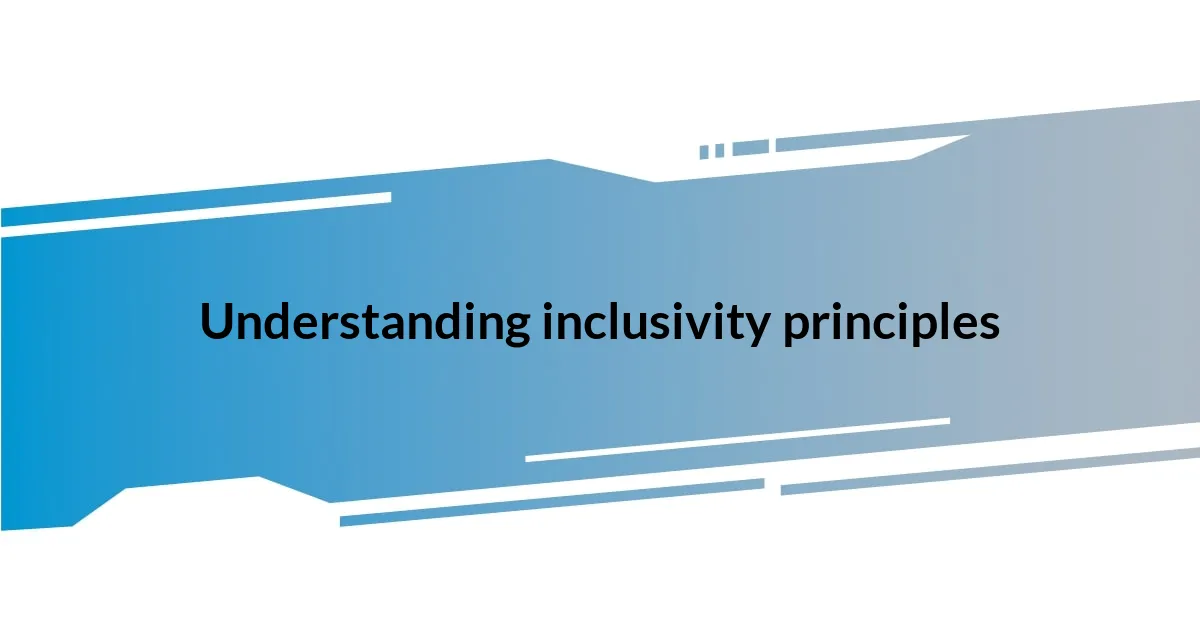
Understanding inclusivity principles
Inclusivity principles are fundamentally about recognizing and valuing the unique perspectives and experiences each person brings to the table. In my own experiences, I’ve often felt the power of being included when my ideas were welcomed in brainstorming sessions. It got me thinking—how often do we actually pause to truly hear each other out?
One essential principle of inclusivity is creating an environment where everyone feels safe to share their thoughts. I remember a team meeting where I hesitated to voice my opinion, worried it might not align with the majority. But when a colleague encouraged me, it opened up a dialogue that led to an innovative approach. It made me realize just how crucial it is to foster spaces where diverse voices can be heard.
Being inclusive also means actively challenging biases—whether they’re conscious or subconscious. I’ll never forget a time when I noticed a colleague struggling to find their place within our group. Instead of assuming they were simply shy, I reached out and learned about their background. That moment illustrated for me that inclusivity isn’t just a buzzword; it’s about building genuine connections and understanding. How can we ensure that these connections are made in our daily interactions?
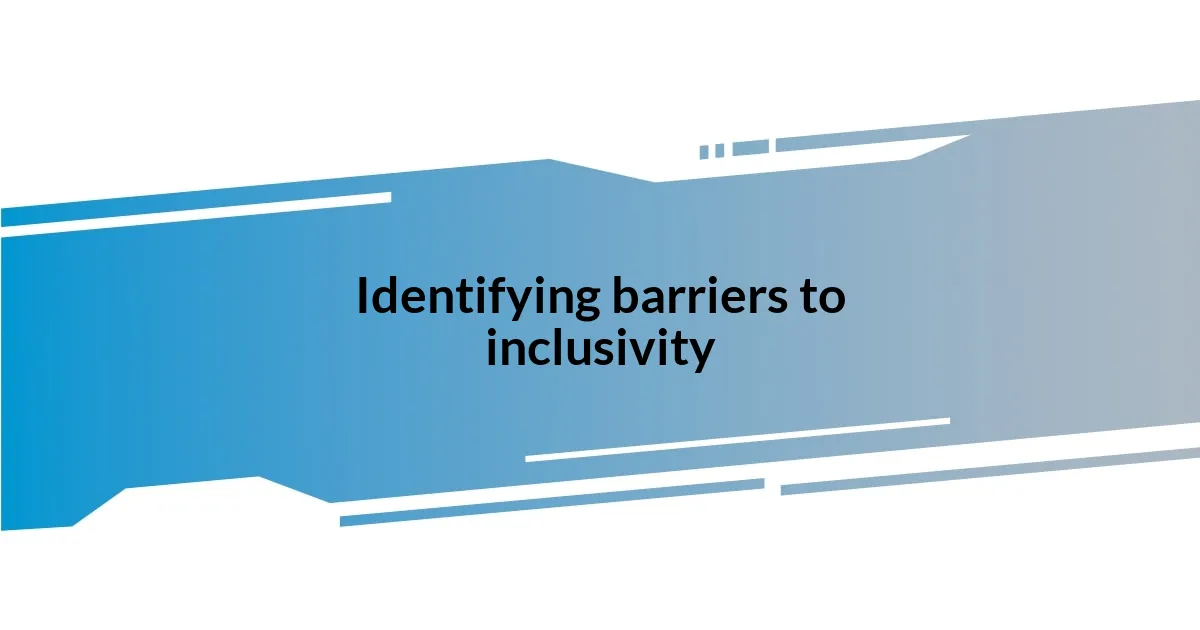
Identifying barriers to inclusivity
Identifying barriers to inclusivity can sometimes feel like navigating a maze. I remember a time when I was part of a project team where some voices were consistently louder than others. It struck me that the quieter team members had brilliant ideas but felt overshadowed. This experience taught me that barriers often stem from power dynamics, where some individuals unintentionally dominate discussions, making it challenging for others to contribute.
Another barrier I’ve encountered is lack of awareness regarding different communication styles. I was once in a situation where a colleague from a different cultural background expressed their ideas very differently than the rest of us were accustomed to. Initially, I misunderstood their input as disengagement. It wasn’t until I took the time to appreciate their perspective that I understood the richness of diversity in expression. This incident underscored for me how crucial it is to recognize and adapt to various communication preferences to foster a truly inclusive environment.
Lastly, structural barriers, such as inadequate support systems, can hinder inclusivity. In my experience volunteering with a non-profit organization, we faced challenges providing resources for differently-abled individuals. It called to mind the importance of advocating for physical and systemic changes that promote accessibility. If we remain unaware of these barriers or choose to overlook them, we deny opportunities for meaningful participation from everyone involved.
| Type of Barrier | Description |
|---|---|
| Power Dynamics | Some voices dominate discussions, overshadowing quieter individuals. |
| Communication Styles | Diverse communication approaches may lead to misunderstandings and disengagement. |
| Structural Support | Lack of resources for differently-abled individuals can result in exclusion. |
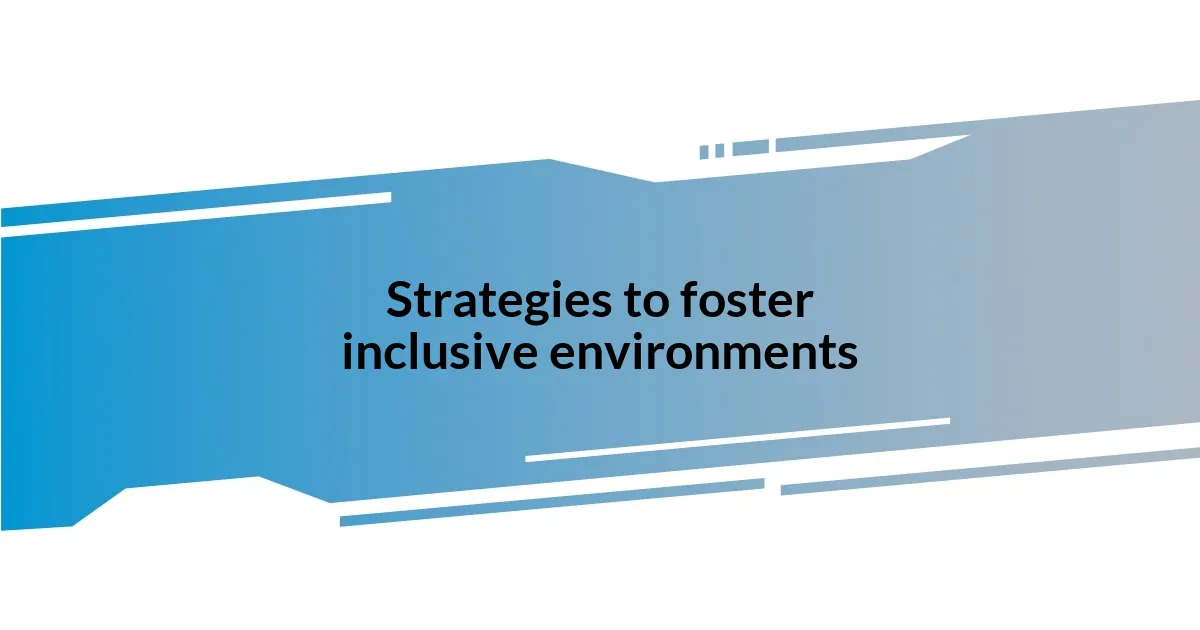
Strategies to foster inclusive environments
In my experience, actively inviting contributions from all team members can transform a group’s dynamic. I once facilitated a workshop where I implemented a “round-robin” sharing technique. This method ensured that everyone had an opportunity to voice their ideas, and it was amazing to witness the creativity that flourished when different perspectives were acknowledged. It reminded me how simple adjustments in approach can create a rich tapestry of collaboration.
Here are some effective strategies:
- Create Safe Spaces: Establish environments where vulnerability is encouraged, allowing individuals to express their ideas without fear.
- Encourage Diverse Perspectives: Actively seek out viewpoints from various backgrounds and experiences during discussions.
- Regular Check-ins: Conduct individual or small group check-ins to give people an opportunity to share their thoughts more comfortably.
- Education on Bias: Offer training sessions that help team members recognize and confront their biases.
- Celebrate Differences: Acknowledge and celebrate cultural or individual differences within the team, reinforcing the value of diversity.
One of my most transformative experiences happened while collaborating with a diverse volunteer group for a community event. We faced the challenge of planning activities that catered to a wide range of abilities and backgrounds. I noticed one member, who often stayed in the background during discussions, had incredible insight about local cultural sensitivities. After encouraging them to share, we developed a program that resonated deeply with the community. This experience showed me how fostering an inclusive environment not only enhances participation but also leads to innovative solutions that might have otherwise gone unheard.
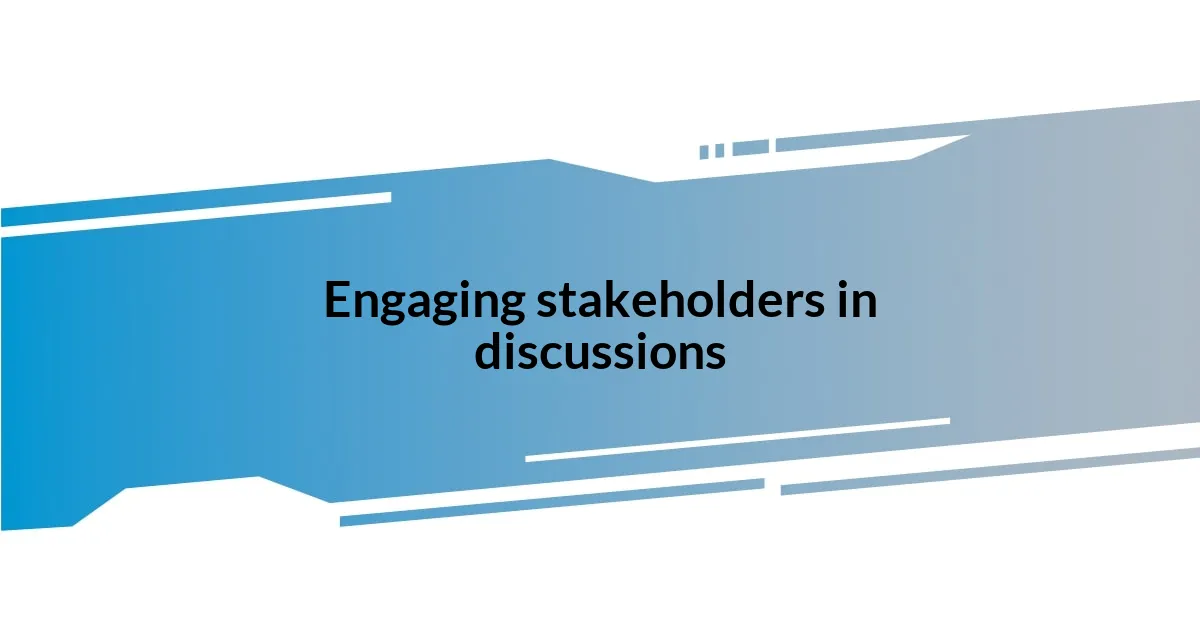
Engaging stakeholders in discussions
Engaging stakeholders in discussions is a vital step toward fostering inclusivity. In a recent meeting with my local community board, I noticed how apprehensive some members were to share their opinions. It made me wonder: how many valuable insights go unnoticed because people hesitate to speak up? To combat this, I started by making the conversation more informal and personal. By encouraging each person to share a story related to the agenda, I saw barriers dissolve and a sense of camaraderie develop.
Listening actively is another essential element when engaging stakeholders. I recall a brainstorming session where I deliberately focused on paraphrasing what quieter members expressed. This not only validated their input but also sparked further discussion. It’s incredible how building rapport through listening can unlock a wealth of ideas and foster an environment in which everyone feels heard and valued. When I engaged stakeholders this way, it truly felt like a collective effort rather than just another meeting.
Furthermore, I find that following up on discussions reinforces the importance of everyone’s contribution. After a planning session for a community initiative, I sent out a summary that highlighted key ideas from each participant. The response I received was heartwarming—people appreciated being acknowledged and eager to share even more thoughts. It clearly showed me that fostering inclusivity isn’t just about the conversation itself; it’s about nurturing ongoing engagement and making sure no voice is left behind.
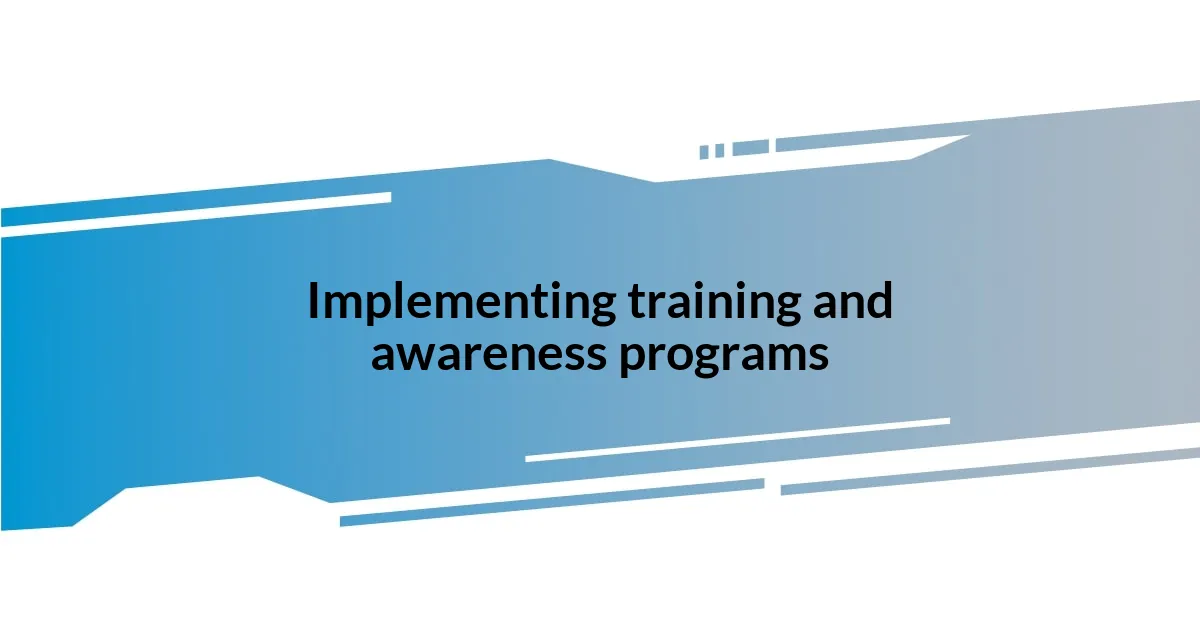
Implementing training and awareness programs
Implementing training and awareness programs is crucial for promoting a culture of inclusivity. I remember attending a company workshop that focused on unconscious bias. It was eye-opening for me to see how our assumptions can unknowingly influence interactions. The activities forced us to confront these biases in a safe environment, leading to deep reflections and discussions that broke down barriers. If we don’t recognize our biases, how can we expect to build an inclusive atmosphere?
I’ve also led sessions that emphasized the importance of empathy in the workplace. One particular session involved role-playing scenarios where team members could experience different perspectives. The genuine reactions from participants were powerful; their emotional insights reflected the need for this type of training. It struck me how stepping into someone else’s shoes—even for a moment—can foster compassion and understanding in a group dynamic.
Beyond initial training, I believe ongoing awareness programs are essential. For instance, I initiated monthly check-ins to revisit our training, allowing us to discuss real-world applications of what we learned. This approach helps reinforce that inclusivity is not a one-time effort but a continuous journey. Don’t you think we all have the potential to grow? Seeing my colleagues engage with these discussions has reinforced my belief that commitment to training breeds lasting change.
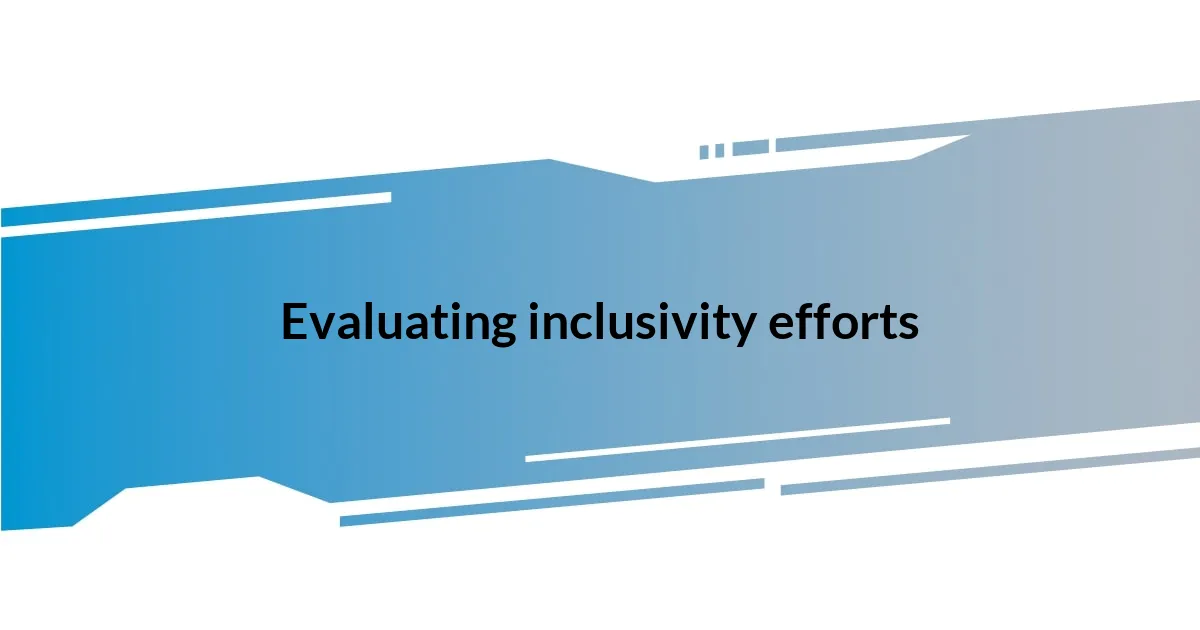
Evaluating inclusivity efforts
Evaluating inclusivity efforts requires ongoing reflection and assessment. I often look back on initiatives I’ve been a part of and ask myself how effective they truly were. For instance, after launching a mentorship program aimed at underrepresented groups, I couldn’t help but wonder: Are we genuinely creating opportunities for these individuals, or is it just a checkbox exercise? Gathering feedback from participants opened my eyes to their experiences, affirming the importance of continuous evaluation.
In a recent project, I used surveys to gauge the impact of inclusive practices on our team dynamics. The results were revealing. Some members felt included while others shared feelings of exclusion. It was a harsh reality check, leading me to initiate one-on-one conversations. Through these discussions, I learned that inclusivity is not a static achievement; it’s a fluid process that requires constant nudging and refining. It made me realize that every voice matters, and the goal should be to amplify the quieter ones.
I also advocate for setting measurable goals. In one initiative, we defined clear metrics for success, like participation rates in various activities. Tracking these numbers made the impact of our efforts tangible. It became evident that when we fell short, we needed to adjust our strategies. My takeaway? Evaluating inclusivity isn’t just about reflection; it’s about creating an action plan that evolves based on real experiences. It keeps us accountable and focused on genuine progress.
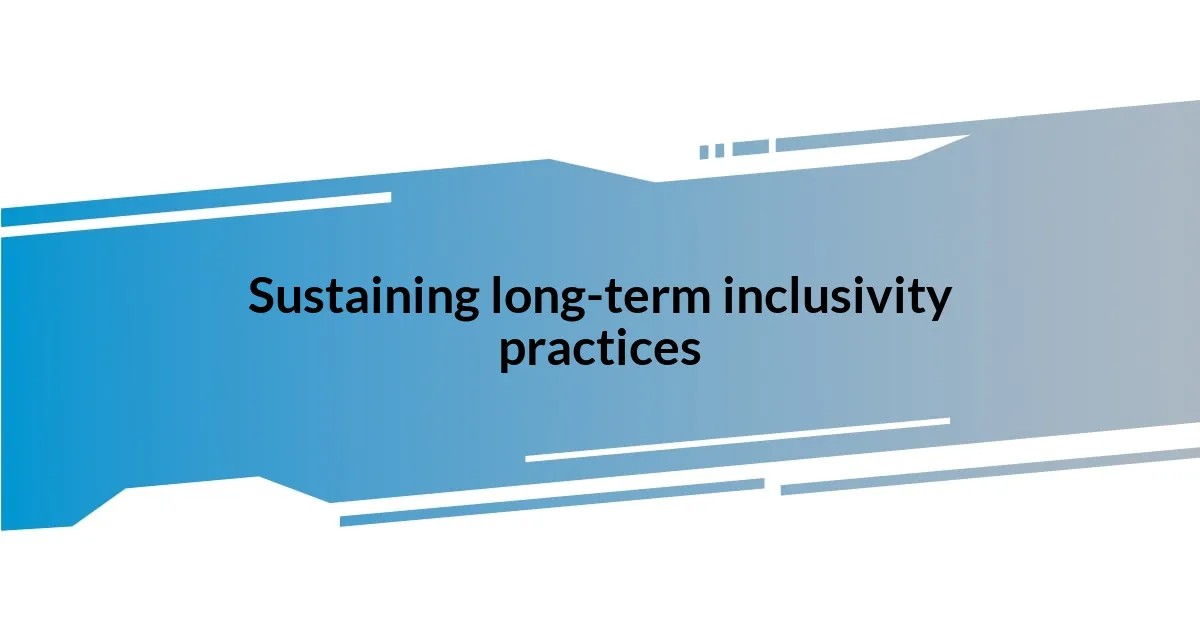
Sustaining long-term inclusivity practices
Sustaining long-term inclusivity practices isn’t just about initiating programs; it’s about weaving inclusivity into the fabric of everyday operations. I vividly recall when my team decided to implement a ‘catch-up’ session every quarter focused solely on inclusivity conversations. During one such meeting, a colleague shared their feelings of being overlooked in decision-making, prompting a heartfelt dialogue that shifted our group dynamics. This was a stark reminder that continuing the conversation is crucial; it can spark changes that reverberate throughout the organization.
Moreover, celebrating wins—big or small—can significantly enhance our commitment to inclusivity. I’ve organized recognition events to highlight individuals or teams who exemplified inclusive practices. Recently, acknowledging a project team for their efforts in making a virtual event accessible to everyone lit a fire in our office. As my peers shared their pride and enthusiasm, I realized that recognizing these efforts cultivates a sense of shared responsibility. Wouldn’t you agree that recognition fuels motivation?
I find it essential to create a feedback loop that invites everyone to contribute to our inclusivity narrative. One memorable experience was when we tried an anonymous suggestion box. Not only did it empower quieter team members to voice their thoughts, but it also unearthed valuable ideas that I hadn’t even considered. This approach taught me that sustainability in inclusivity practices hinges on open communication and genuine engagement. Who knew a simple box could lead to such profound insights?